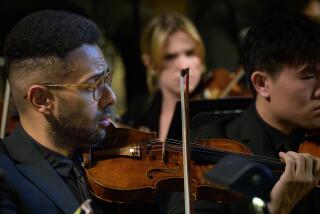MUSIC REVIEW : Pianist Blocker in Royce Hall Debut
- Share via
Musical Los Angeles gathers very seldom, but then, usually with good reason. The good reason Sunday night in Royce Hall at UCLA was the local debut recital of pianist Robert Blocker.
Robert Blocker? A Cliburn winner? A Fleischmann discovery? The newest sensation from Vienna?
None of the above. Blocker is the new Dean of the School of the Arts at UCLA, a recently created post encompassing not only six major arts departments, but also the UCLA Center for the Arts. An informal gauge of the importance of the new post--which without exaggeration might be called a Tsardom--could be been in the composition of the large, well-dressed audience attending Blocker’s first appearance.
And how does the new dean play the piano? With great skill and accomplishment, a measurable virtuoso bent and considerable musical sensitivity.
Blocker did not choose a safe program for this debut. Instead, he proved his courage and eclecticism.
He started with a famous, once-maligned, now-fashionable Bach transcription, that of the D-minor Chaconne by Ferruccio Busoni, producing some very mellow tones possible in the Royce Hall Steinway in simulation of not the original violin sound in the Partita No. 2 but some resonant, deep-voiced pipe organ of the imagination.
Without losing or trivializing the virtuosic content of the transcription, the 45-year-old Blocker produced results that were, as pure sound, memorable.
At the other end of the evening, Blocker closed the proceedings with a single encore of more Bach: his own transcription of the Sinfonia from Cantata No. 106, “Gottes Zeit ist die allerbeste Zeit.” What hidden agenda lies in that, the assorted musical politicos may still be considering. As a performance, however, and a reminder of the ever-present fact that making music is a spiritual activity, it succeeded deeply.
The rest of the evening kept to the high road, Blocker showing his stuff as both barnstormer and poet. In two Nocturnes and the F-minor Fantasy by Chopin, he displayed style and resource and an edge-less tone at every level. Very handsome, very sweeping and highly nuanced Ravel followed intermission in the “Valses Nobles et Sentimentales,” which lacked only the extra colors a better, less recalcitrant instrument might have offered the pianist.
In the Piano Sonata by Ginastera--amazingly, the work, dedicated to Johana Harris, who played its premiere, is now 40 years old--Blocker provided an appropriate tour de force in his finale.
As we all know by now, the heart of the work is its wondrous Adagio. There, as well as in his two Bach performances, the pianist achieved his most mesmerizing moments, without of course letting down the urgency, climaxes and triumphs of the outer movements.
More to Read
The biggest entertainment stories
Get our big stories about Hollywood, film, television, music, arts, culture and more right in your inbox as soon as they publish.
You may occasionally receive promotional content from the Los Angeles Times.










